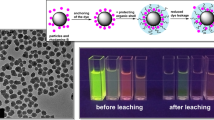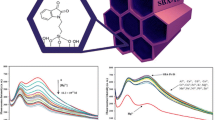Abstract
Fluorescence characteristics of hemicyanine dye molecules isolated from neighboring molecules and strongly restricted inside nanosized pores of zeolite (silicalite-1) crystal were investigated. For samples in which the molecules were sufficiently far away from the others, the fluorescence decay lifetime of the molecules was about 2.2 ns. As the intermolecular distance was reduced, the steady-state fluorescence peak shifted toward the longer wavelength and the fluorescence efficiency decreased markedly. The fluorescence decay lifetime also decreased to 0.8 ns for a sample with the smallest intermolecular distance of 2.1 nm. These results were explained in terms of a dipole-dipole interaction between pairs of dye molecules. From the relation between the intermolecular distances and the fluorescence decay lifetimes of the molecules, the radius of energy transfer of hemicyanine donor-acceptor pair in zeolite matrix was determined to be 2.2 nm, in fair agreement with the calculated Förster radius between dye molecules of the same species.





Similar content being viewed by others
References
Calzaferri G, Huber S, Maas H, Minkowski C (2003) Host–guest antenna materials. Angew Chem Int Ed 42(32):3732–3758
Nguyen T, Wu J, Doan V, Schwartz BJ, Tolbert SH (2000) Control of energy transfer in oriented conjugated polymer-mesoporous silica composites. Science 288(5466):652–656
Kim HS, Lee S, Ha K, Jung C, Lee Y, Chun Y, Kim D, Rhee BK, Yoon KB (2004) Aligned inclusion of hemicyanine dyes into silica zeolite films for second harmonic generation. J Am Chem Soc 126(2):673–682
Macchi G, Botta C, Calzaferri G, Catti M, Cornil J, Gierschner J, Meinardi F, Tubino R (2010) Weak forces at work in dye-loaded zeolite materials: spectroscopic investigation on cation–sulfur interactions. Phys Chem Chem Phys 12(11):2599–2605
Shim TK, Lee MH, Kim D, Kim HS, Yoon KB (2009) Fluorescence properties of hemicyanine in the nanoporous materials with varying pore sizes. J Phys Chem B 113(4):966–969
Förster Th (1948) Intermolecular energy migration and fluorescence. Ann Phys (Leipzig) 2(6):55–75
Andrews DL, Demidov AA (1999) Resonance energy transfer. John Wiley & Sons, England, pp 151–172
Valeur B (2002) Molecular fluorescence: principles and applications. Wiley-VCH, Weinheim, Germany, pp 247–272
Lakowicz JR (2006) Principles of Fluorescence Spectroscopy, 3rd edn. Springer, New York, pp 443–475
Calzaferri G, Lutkouskaya K (2008) Mimicking the antenna system of green plants. Photochem Photobiol Sci 7(8):879–910
Busby M, Blum C, Tibben M, Fibikar S, Calzaferri G, Subramaniam V, Cola LD (2008) Time, space, and spectrally resolved studies on J-aggregate interactions in zeolite L nanochannels. J Am Chem Soc 130(33):10970–10976
Vohra V, Devaux A, Dieu LQ, Scavia G, Catellani M, Calzaferri G, Botta C (2009) Energy transfer in fluorescent nanofibers embedding dye-loaded zeolite L crystals. Adv Mater 21(10–11):1146–1150
Vietze U, Krass O, Laeri F, Ihlein G, Schueth F, Limburg B, Abraham M (1998) Zeolite-dye microlasers. Phys Rev Lett 81(21):4628–4631
Li IL, Tang ZK, Xiao XD, Yang CL, Ge WK (2003) Optical properties of organic dyes in nanoporous zeolite crystals. Appl Phys Lett 83(12):2438–2441
Cox SD, Gier TE, Stucky GD, Bierlein J (1988) Inclusion tuning of nonlinear optical materials: switching the SHG of p-nitroaniline and 2-methyl-p-nitroaniline with molecular sieve hosts. J Am Chem Soc 110(9):2986–2987
Gao F, Zhu G, Chen Y, Qiu S (2004) Assembly of p-nitroaniline molecule in the channel of zeolite MFI large single crystal for NLO material. J Phys Chem B 108(11):3426–3430
Shim TK, Kim D, Lee MH, Rhee BK, Cheong HM, Kim HS, Yoon KB (2006) Determination of the hyperpolarizability components of hemicyanine dyes by measuring the anisotropic fluorescence and second harmonic of the dyes uniformly aligned within zeolite channels. J Phys Chem B 110(34):16874–16878
Szulbinski WS, Ma’nuel DJ, Kincaid JR (2001) Zeolite-entrapped organized molecular assemblies. New evidence for highly efficient adjacent cage dyad formation and constrained rotational mobility of tris-Ligated polypyridine complexes. Inorg Chem 40(14):3443–3447
Hashimoto S, Moon HR, Yoon KB (2007) Optical microscopy study of zeolite-dye composite materials. Microporous Mesoporous Mater 101(1–2):10–18
Hinds EA (1990) Cavity quantum electrod dynamics. Adv At Mol Opt Phys 2:237–289
Solomon GS, Pelton M, Yamamoto Y (2001) Single-mode spontaneous emission from a single quantum dot in a three-dimensional microcavity. Phys Rev Lett 86(17):3903–3906
Chance RR, Prock A, Silbey R (1978) Molecular fluorescence and energy transfer near interfaces. Adv Chem Phys 37:1–65
Andrews P, Barnes WL (2004) Energy transfer across a metal film mediated by surface plasmon polaritons. Science 306(5698):1002–1005
Lakowicz JR (2001) Radiative decay engineering: biophysical and biomedical applications. Anal Biochem 298(1):1–24
Ali M, Ahmed SA, Kitwally K (1989) Fluorescence and gain predictions in laser dye mixtures. Appl Opt 28(17):3708–3712
Schuler B, Lipman EA, Eaton WA (2002) Probing the free-energy surface for protein folding with single-molecule fluorescence spectroscopy. Nature 419(6908):743–747
Michalet X, Kapanidis AN, Laurence T, Pinaud F, Doose S, Pflughoefft M, Weiss S (2003) The power and prospects of fluorescence microscopies and spectroscopies. Annu Rev Biophys Biomol Struct 32:161–182
Kajihara D, Abe R, Iijima I, Koiyama C, Sisido M, Hohsaka T (2006) FRET analysis of protein conformational change through position-specific incorporation of fluorescent amino acids. Nat Methods 3:923–929
Joo C, Balci H, Ishitsuka Y, Buranachai C, Ha T (2008) Advances in single-molecule fluorescence methods for molecular biology. Annu Rev Biochem 77:51–76
Borgia A, Williams PM, Clarke J (2008) Single-molecule studies of protein folding. Annu Rev Biochem 77:101–125
Weber G (1954) Dependence of the polarization of the fluorescence on the concentration. Trans Faraday Soc 50:552–555
Johnson ID, Kang HC, Haugland RP (1991) Fluorescent membrane probes incorporating dipyrrometheneboron difluoride fluorophores. Anal Biochem 198(2):228–237
Patterson GH, Piston DW, Barisas BG (2000) Förster distances between green fluorescent protein pairs. Anal Biochem 284(2):438–440
Isaksson M, Kalinin S, Lobov S, Wang S, Nyb T, Johansson LB (2004) Partial donor–donor energy migration (PDDEM): a novel fluorescence method for internal protein distance measurements. Phys Chem Chem Phys 6(11):3001–3008
Turro NJ (1991) Modern Molecular Photochemistry. University Science, Mill Valley, pp 305–311
Schuth F (1992) Polarized fourier transform infrared microscopy as a tool for structural analysis of adsorbates in molecular sieves. J Phys Chem 96(19):7493–7496
Kox MHF, Stavitski E, Weckhuysen BM (2007) Nonuniform catalytic behavior of zeolite crystals as revealed by in situ optical microspectroscopy. Angew Chem Int Ed 46(20):3652–3655
Karwacki L et al (2009) Morphology-dependent zeolite intergrowth structures leading to distinct internal and outer-surface molecular diffusion barriers. Nat Mater 8:959–965
Assuming a random distribution of molecules in zeolite, statistically the dyes can be closer than N -1/3 by as much as 0.554 (Chandrasekhar S (1943) Stochastic problems in physics and astronomy. Rev Mod Phys 15(1):1–89). This aspect has not been taken into account in our ensemble-averaged measurements, but can be used in more elaborate analysis especially when one considers that the dyes closer together would transfer energy much more efficiently
Schuler B, Lipman EA, Steinbach PJ, Kumke M, Eaton WA (2005) Polyproline and the “spectroscopic ruler” revisited with single-molecule fluorescence. Proc Natl Acad Sci U S A 102(8):2754–2759
The fluorescence decay lifetime is a better and more quantitative measure of the Förster energy transfer as compared to the fluorescence intensity which is affected by the alignment of the pump-beam and the detection as well as the spectral response of the detector (Shim K, Kim S, Kim D, Oh-e M (2011) Fluorescence enhancement of dye-doped liquid crystal by dye-induced alignment effect. J Appl Phys 110(6): 063532)
Devaux A, Calzaferri G (2009) Manipulation of energy transfer processes in nanochannels. Int J Photoenerg 2009:9–17
Busby M, Devaux A, Blum C, Subramaniam V, Calzaferri G, Cola LD (2011) Interactions of perylene bisimide in the one-dimensional channels of zeolite L. J Phys Chem C 115(13):5974–5988
Lutkouskaya K, Calzaferri G (2006) Transfer of electronic excitation energy between randomly mixed dye molecules in the channels of zeolite L. J Phys Chem B 110(11):5633–5638
Blumen A (1981) On the anisotropic energy transfer to random acceptors. J Chem Phys 74(12):6926–6933
van der Meer BW (2002) Kappa-squared: from nuisance to new sense. Rev Mol Biotechnol 82:181–196
Eisenthal KB, Siegel S (1964) Influence of resonance transfer on luminescence decay. J Chem Phys 41(3):652–655
Steinberg IZ (1968) Nonradiative energy transfer in systems in which rotatory brownian motion is frozen. J Chem Phys 48(6):2411–2413
Cao X, Tolbert RW, Mchale JL, Edwards WD (1998) Theoretical study of solvent effects on the intramolecular charge transfer of a hemicyanine dye. J Phys Chem A 102(17):2739–2748
Strehmel B, Seifert H, Rettig W (1997) Photophysical properties of fluorescence probes. 2: a model of multiple fluorescence for stilbazolium dyes studied by global analysis and quantum chemical calculations. J Phys Chem B 101(12):2232–2243
Shim T, Lee M, Kim S, Sung J, Rhee BK, Kim D, Kim H, Yoon KB (2004) Photoluminescence decay lifetime measurements of hemicyanine derivatives of different alkyl chain lengths. Mater Sci Eng C 24(1):83–85
Shim T, Lee M, Kim D, Ouchi Y (2008) Comparison of photophysical properties of the hemicyanine dyes in ionic and nonionic solvents. J Phys Chem B 112(7):1906–1912
Dulkeith E, Morteani AC, Niedereichholz T, Klar TA, Feldmann J, Levi SA, van Veggel FCJM, Reinhoudt DN, Möller M, Gittins DI (2002) Fluorescence quenching of dye molecules near gold nanoparticles: radiative and nonradiative effects. Phys Rev Lett 89(20):203002–203005
Tomin VI (2009) Fluorescence quenching of photoreaction products in the excited singlet state. Russ J Phys Chem A 83(3):493–498
Acknowledgments
This work was supported by the Korean Government (MEST) grant No. 2011-0017435, SRF grant (201214003) of the Sogang University, and by the Korea Center for Artificial Photosynthesis located in Sogang University funded by MEST through the National Research Foundation of Korea (NRF-2009-C1AAA001-2009-0093879).
Author information
Authors and Affiliations
Corresponding author
Rights and permissions
About this article
Cite this article
Shim, T.K., Lee, M.H., Kim, D. et al. Fluorescence Characteristics of Isolated Dye Molecules within Silicalite-1 Channels. J Fluoresc 22, 1475–1482 (2012). https://doi.org/10.1007/s10895-012-1084-7
Received:
Accepted:
Published:
Issue Date:
DOI: https://doi.org/10.1007/s10895-012-1084-7




